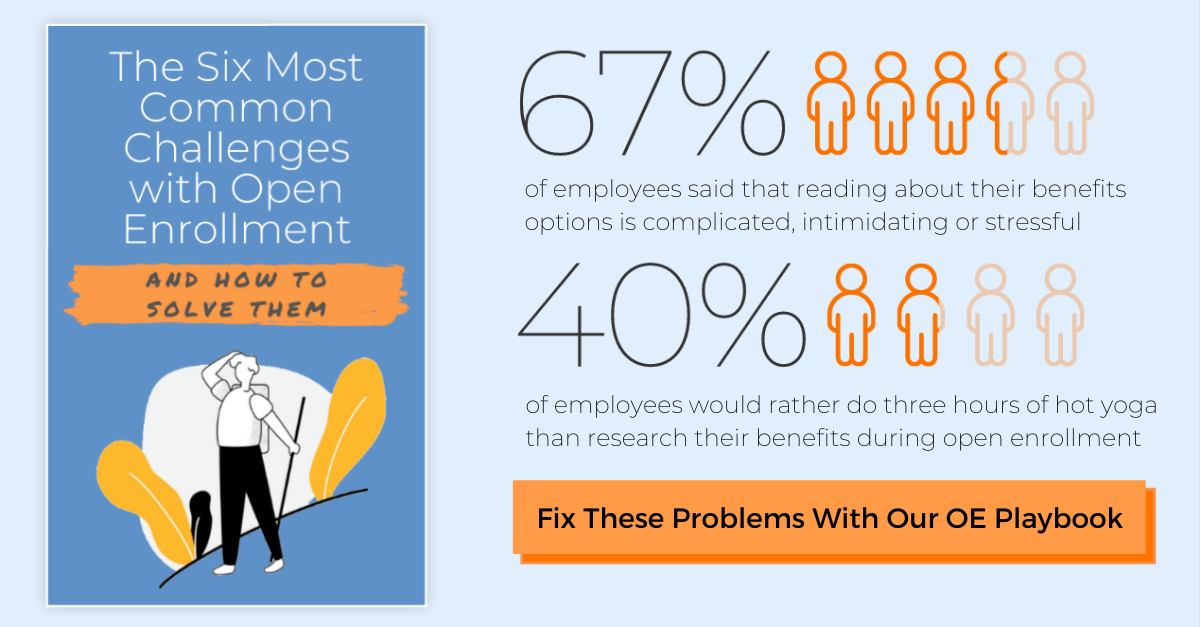Last year, we helped conduct 200 open enrollment campaigns to nearly 750,000 employees. What would you want to know if you had access to that type of data set?
We dug through all that data with a focus on pulling out actionable insights to help HR teams reach maximum employee engagement during OE. Below you’ll find six fundamental takeaways that leapt out at us, with some dos and don’ts for each area.
Takeaway #1: Use a Benefits Decision Support Tool
Campaigns featuring a benefits decision support tool in 2020 showed a higher-than average engagement rate (a 76% average on campaigns featuring decision-support tools vs the 72% aggregate average), and this number would be even higher once factoring in decision support that is embedded in places like corporate intranets.
Employees find that a decision-support tool provides an “Amazon-like” benefits-shopping experience. This simplified approach to researching, evaluating options, and selecting plans successfully reduces stress and improves enrollment results.
Do:
- Use a benefits decision-support tool, to help employees make better medical and/or voluntary benefits selections based on their personal needs and circumstances.
Don’t:
- Rely solely on benefits guides for benefit-plan education. Employees find the benefits-selection process confusing and intimidating*, but self-guided education and support tools remove stress and guesswork.
(Want more? Read our 101 overview of benefits decision support tools.)
Takeaway #2: Push More Frequent Messaging with Less Content
Want better results? Think small.
The best communicators in 2020 sent more messages with less text and increased focus. While deadlines and enrollment portal access information were typically included in every message, supplemental information (benefits tips, explainer videos, information around voluntary benefits) was split across a longer communications effort.
This focused approach resulted in better knowledge and improved results.
Do:
- Include the most essential information, like enrollment deadlines, in every message.
- Use focused messaging around specific education points to improve engagement and benefits knowledge.
Don’t:
- Overwhelm employees with messaging that covers too much information at once.
- Send a single email. You should send at least three emails: one before OE, another at the start of OE, and one a few days before the deadline.
Takeaway #3: Tailor Messaging to Match the Audience
Customization of employee benefits and communication has become part of improving the employee experience. But this is typically time intensive, requiring a lot of one-on-one interactions. But today’s digital technology can allow teams to supplement (or even replace) many of their one-on-one benefits communications.
Digital content, like Digital Postcards for example, can easily be customized with unique messaging or different languages.
Do:
- Tailor messaging based on employee segment (location, union, FTE vs. part time, etc.) and interests (retirement planning, supplemental benefits, etc.)
Don’t:
- Take a one-size-fits-all approach to your benefits-communication strategy. Not only will a more customized approach improve your results, but it will also cut down on redundant meetings and questions.
Takeaway #4: Offer More Resources and More Options in More Types of Methods
Visually compelling content and more frequent distribution of content was an overarching theme for open enrollment communications. The pandemic highlighted the need for benefits like telehealth options, mental health, wellness, and hospital-indemnity coverage. There was a greater emphasis on self-guided education around voluntary benefits, which requires more engaging visual content, like videos and Digital Postcards, with more frequent and focused distribution.
Do:
- Include more opportunities for action on your content, linking out to enrollment portals, guides, videos, and other employee tools.
- Promote your content. Providing the tools and education is only half of the battle; the other half is promoting them and improving awareness.
Don’t:
- Rely too heavily on email, particularly all-text email that is often ignored.
- Underestimate the power of video. It is, by far, the top method requested* for employee benefits education.
Takeaway #5: Use Digital and Mobile-Friendly Print Materials
QR code usage more than doubled and mobile-device views were up. Mobile and QR codes are traditionally great ways to reach workforces that are not often in front of their computers, such as retail, manufacturing, and construction. In those industries, we saw mobile-device views above the average.
QR codes on printed materials in public spaces are also a great way to reinforce messaging and create additional benefits communication touchpoints.
Do:
- Optimize content for mobile devices and make it accessible.
- Use QR codes and other printed materials in public workspaces.
- Use employee texting to improve open rates on the most critical benefits communications, like approaching deadlines.
Don’t:
- Focus on a single channel for your open enrollment campaigns. Different channels will resonate with different employees, so a multi-channel approach is ideal.
Takeaway #6: Be Extremely Clear About Active vs. Passive Enrollment
Of course, it’s expected that engagement is high during active-enrollment years. But how much higher? We found that campaigns that specified it was an active-enrollment period (either in text on the Postcard or within featured video content) saw an engagement rate almost 30% higher than those that were explicitly passive or where active/passive wasn’t specified at all (92% engagement rate compared to 63% engagement).
However, 63% engagement during passive enrollment is still really high! And you know as well as we do that some employees would benefit from taking an active approach during a passive enrollment year: the plan they chose last year might no longer be the right plan for them.
Do:
- Be extremely clear with employees if they have to make an active-enrollment decision this cycle, and the consequences if they don’t.
Don’t:
- Skimp on communication campaigns during passive cycles. Passive campaigns still get over 60% engagement, and it’s a critical strategy to improve benefits awareness and happiness.
Are you getting over 70% engagement during your open enrollment?
Simplify benefits enrollment with decision support, explainer videos, and content-driven communications. Have your easiest (and best-performing) open enrollment ever. Learn more here.
Want to learn more about solving the most common challenges of open enrollment? Download our new playbook.







